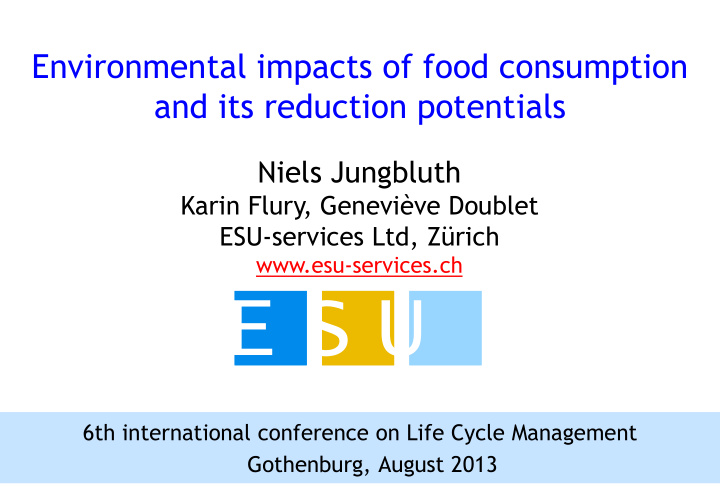



Environmental impacts of food consumption and its reduction potentials Niels Jungbluth Karin Flury, Geneviève Doublet ESU-services Ltd, Zürich www.esu-services.ch E E U U S S 6th international conference on Life Cycle Management Gothenburg, August 2013
Key questions • What are the total environmental impacts of consumption and how can they be allocated to consumption areas? • What are the most important aspects within the food consumption area? • Which potentials exist for the reduction of environmental impacts due to food consumption? Difficulties and rebound effects for implementation are not considered Page 2 www.esu-services.ch
Background • Different projects financed by – WWF Switzerland – Energieforschung Zurich – ewz-electricity supply Zurich – Swiss Federal Office for the Environment, FOEN • Here we present our personal point of view • www.esu-services.ch/projects/lifestyle/ www.esu-services.ch Page 3
Life cycle impact assessment • It is necessary to use a single score method to make this type of assessment and provide clear recommendations (feasibility of environmental product information www.esu-services.ch/projects/epi/) • Use of the LCIA method ecological scarcity 2006 (Switzerland) • Further evaluation of greenhouse gas emissions and energy use for comparison with older studies Page 6 www.esu-services.ch
Five main stages for the calculation 1. Total impacts CH 5. Total red. potentials 2. Share of consumption areas 3. Further analysis 4. Reduction potential in cons. area of cons. area Mahlzeiten in Kantinen: Ökologische Knappheit 2006 10000 Umweltbelastungspunkte 2006 pro Mahlzeit 9000 8000 ø 6700 Pts. Stärkebeilage 7000 Gemüsebeilage 6000 Hauptzutat 5000 4000 ø 2100 Pts. 3000 2000 1000 0 Rindsschmorbraten, Pommes, Zucchetti Schweinskotelett, Pommes, Gemüse Kalbsgeschnetzeltes, Fleischmahlzeit Gemüsecurry im Risotto Spätzlipfanne Tofugeschnetzeltes, Karottengemüse Gemüselasagne Vegetarische Pouletschenkel, Pommes frites Lammragout, Karottengemüse Vollreisring Rösti, Karotten Mahlzeit Gebratener Rösti, Rösti, www.esu-services.ch Page 9
1. TOTAL IMPACTS IN SWITZERLAND MEAN FIGURES OF SWISS EE-IOA AND SIMPLIFIED “ LCA&TRADE STATISTICS” APPROACH
Total balance of Swiss impacts 20 Million eco-points per year and capita Page 11 www.esu-services.ch
2. SHARE OF CONSUMPTION AREAS CALCULATION WITH SWISS EE-IOA
Share of consumption areas in 2005 www.esu-services.ch Page 15
Share of consumption areas Nutrition is the most important consumption area with 28% Share of restaurants not included in this figure
3. FURTHER ANALYSIS OF CONSUMPTION AREAS TOP-DOWN AND BOTTOM-UP ASSESSMENT WITH LCA AND COMPARISON WITH EE-IOA
Environmental impacts of food purchases Top-Down and bottom-up come to comparable results Further analysis of consumption areas based on LCA and statistics
Product groups within nutrition Meat and animal products cause 44% of total impacts Wine, coffee and beer are important for beverages Seite 21 www.esu-services.ch
4. REDUCTION POTENTIALS ANALYSIS OF EIGHT SINGLE CHANGES IN FOOD CONSUMPTION
Buy locally Switzerland imports 50% of food: No full self-supply possible NO airplane transports is modelled as “locally” option Page 23 www.esu-services.ch
Buy seasonally No fruits and vegetables from heated greenhouses Page 24 www.esu-services.ch
Eat vegetarian No meat and fish products Page 25 www.esu-services.ch
Organic food products The whole food basket from organic production No heated greenhouses and air-transports Extra import-transports because of lower yields Page 26 www.esu-services.ch
Resign on luxury food No consumption of coffee, alcohol and chocolate Page 27 www.esu-services.ch
No food wasted by consumers Consumers do not throw away food Page 28 www.esu-services.ch
Reduce obesity to normal weight About 37% of Swiss population is overweighed Recommended diet for everyone Page 29 www.esu-services.ch
Healthy and environmentally friendly diet Combine different changes like reduced meat and luxury product consumption, seasonal and local Page 30 www.esu-services.ch
4. REDUCTION POTENTIALS ESTIMATION WITH LITERATURE REVIEW AND OWN CALCULATIONS
Buy Organic products Reduction potential about 16% if only organic food is bought Page 32 www.esu-services.ch
5. TOTAL POTENTIALS ANALYSIS FOR THE PRESENT SITUATION IN SWITZERLAND
Total potential for reduction of impacts Multiplying Reduction Potential and Share of Consumption Area Most relevant is a reduction of animal products Buying local/seasonal low potential because only vegetables and fruits affected
Summary • Our methodology allows to investigate and compare the impacts of behavioural changes in all areas of consumption • Most important are the areas of nutrition, mobility and energy use in households • Combination of EE-IOA for broad overview and LCA for detailed analysis is feasible • The highest potential within the area of food consumption exist for a healthy combination of less animal and luxury products and purchase of organic produced food items, without wastage www.esu-services.ch Page 41
Granted, Here I can enjoy the local my car consumes a lot ... asparagus, But, Your Californian Thanks for financial contributions: But it took me 950 litres of oil to asparagus needs also 5 WWF Switzerland travel 18'777 km to Peru! litres per kg (in Energieforschung Zurich – ewz- Switzerland)! electricity supply Zurich Swiss Federal Office for the Environment, FOEN Further information about the projects www.esu-services.ch/projects/lifestyle/ WWF Footprint calculator to be updated with the data www.footprint.ch Download of the background study and electronic data www.esu-services.ch/projects/ioa/ ESU data-on-demand for food production and consumption www.esu-services.ch/data/data-on-demand/ The relevance of single decisions Discussion forum LCA on sustainable consumption www.esu-services.ch/news/df/#c833 has to be taken into account Page 42
Recommend
More recommend